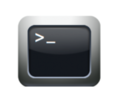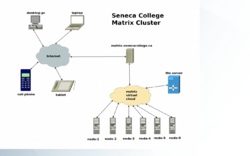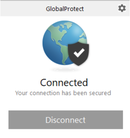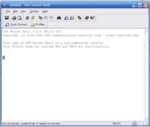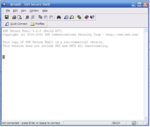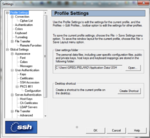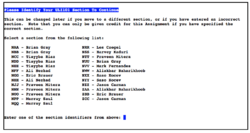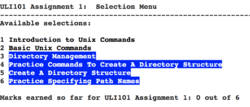Difference between revisions of "Tutorial 1: Using Your Matrix Server Account"
(→CONNECTING TO YOUR MATRIX ACCOUNT FROM COMMAND LINE) |
(→CONNECTING TO YOUR MATRIX ACCOUNT FROM COMMAND LINE) |
||
| Line 143: | Line 143: | ||
# Try connecting to your Matrix account using the instructions in the table below based on <u>your</u> '''current operating system'''.<br><br> | # Try connecting to your Matrix account using the instructions in the table below based on <u>your</u> '''current operating system'''.<br><br> | ||
<table style="margin-left:50px;"> | <table style="margin-left:50px;"> | ||
| − | <tr valign="top"> | + | <tr valign="top" style="text-align:center;"> |
| − | < | + | <th>'''Newer Version of Windows 10:'''</th> |
| − | '''Newer Version of Windows 10:'''< | + | <th>'''MacOSX:''' </th> |
| + | <th>'''Linux:''' </th> | ||
| + | </tr> | ||
| + | <tr> | ||
*From the start menu, type '''cmd''' and launch program | *From the start menu, type '''cmd''' and launch program | ||
*In the command line, enter the following command:<br><span style="color:blue;font-weight:bold;font-size:.75em;">ssh senecausername@matrix.senecacollege.ca</span> | *In the command line, enter the following command:<br><span style="color:blue;font-weight:bold;font-size:.75em;">ssh senecausername@matrix.senecacollege.ca</span> | ||
| Line 151: | Line 154: | ||
</td> | </td> | ||
<td> | <td> | ||
| − | |||
*Launch '''Terminal''' from the '''finder''' utility | *Launch '''Terminal''' from the '''finder''' utility | ||
*In the command line, enter the following command:<br><span style="color:blue;font-weight:bold;font-size:.75em;">ssh senecausername@matrix.senecacollege.ca</span> | *In the command line, enter the following command:<br><span style="color:blue;font-weight:bold;font-size:.75em;">ssh senecausername@matrix.senecacollege.ca</span> | ||
*Enter your password when prompted.<br>Answer '''yes''' to any questions it may ask you. | *Enter your password when prompted.<br>Answer '''yes''' to any questions it may ask you. | ||
</td> | </td> | ||
| − | <td | + | <td> |
| − | |||
*From the menu, choose:<br>'''Applications''' > '''System Tools''' > '''Terminal'''. | *From the menu, choose:<br>'''Applications''' > '''System Tools''' > '''Terminal'''. | ||
*In the command line, enter the following command:<br><span style="color:blue;font-weight:bold;font-size:.75em;">ssh senecausername@matrix.senecacollege.ca</span> | *In the command line, enter the following command:<br><span style="color:blue;font-weight:bold;font-size:.75em;">ssh senecausername@matrix.senecacollege.ca</span> | ||
Revision as of 08:38, 15 September 2020
Contents
LEARNING ABOUT YOUR MATRIX SERVER ACCOUNT
Main Objectives of this Practice Tutorial
- Learn how to connect to your Matrix server account from a remote computer.
- Learn how to effectively use the Linux Shell (command prompt).
- Understand the Linux command structure and how to get help with Linux command usage.
- Perform the first two sections on the online assignment #1 to issue general Linux commands.
- Exit your Matrix Linux Account
- Perform Review Questions for additional Linux Command Practice
- Perform Review Questions for additional Linux Command Practice
Tutorial Reference Material
| Course Notes / Software |
Linux Command/Shortcut Reference |
YouTube Videos | ||
| Slides:Tutorials:Windows SSH client Software: | Logging Out of Matrix Server
Account Access Shell Command Line Editing |
General Linux Commands
|
Brauer Instructional Videos: | |
KEY CONCEPTS
Purpose of Having a Matrix Account
While attending Seneca College, you will be using many different computer systems. Some of these servers include:
| my.senecacollege.ca | Learning Content Management System (Student Grades / Notes / Online Quizzes) |
| ict.senecacollege.ca | Main ICT Webserver |
| wiki.cdot.senecacollege.ca | Course WIKIs for Seneca College Students |
| matrix.senecacollege.ca | Linux Account for Student Practice and Assignment submission |
Although you need to study concepts throughout this course, you will also need to learn to issue simple as well as more advanced Linux commands. This requires that you practice issuing Linux commands on a frequent basis to become more comfortable when working within the Unix and Linux command-line environments.
For this course, it is important to learn how to open a command prompt in order to issue commands to perform common tasks. In Unix/Linux, a shell is simply an interface / interpreter to allow a user to communicate with the Linux computer system (server). Linux shells have evolved (improved) over a period of time. You will be using the Bash Shell which is considered to be user-friendly. By understanding how to issue Linux commands, you can create a file consisting of Linux commands and programming techniques called a shell script (learned later in this course) to automate tasks to make you a more productive user and administrator.
Layout of the Matrix Server
The Matrix server consists of several Virtual Computers connected together to form a cluster. A cluster is a cost effective alternative to buying larger servers.
All registered students in this course should have an account on the Matrix server. You will be using this account for the following reasons:
- Issuing Linux commands
- Becoming productive using the Linux command prompt (shell)
- Performing Linux Practice Tutorials
- Performing Linux Assignments (3)
- Practice Issuing Linux Command Review Questions
Connecting to the Seneca Global Portal
As of September 1 2020, all Seneca College students are required to connect to the Seneca Global Portal
in order to be able to connect to their Matrix Linux account.
Seneca College are "rolling-out" additional measures to improve network security. One of these measures are to implement
multi-factored authentication.
Multi-factor authentication is an electronic authentication method in which a computer user is granted access to a website or application only after successfully presenting two or more pieces of evidence (or factors) to an authentication mechanism: knowledge (something the user and only the user knows). Reference: https://en.wikipedia.org/wiki/Multi-factor_authentication
Although this process will be "rolled-out" over time, the Matrix server is affected for the Fall 2020 semester and onward.
NOTE: If you haven't done this yet, please perform the steps provided in the following link:
https://inside.senecacollege.ca/its/services/vpn/
In the next investigation, you will learn how to connect to and login to your Matrix server account from a remote computer
such as your home desktop computer or your laptop computer.
Connecting to Your Matrix Account
After connecting to the Seneca Global Portal, you can open a terminal in your Newer Windows 10, Mac or Linux computer and issue the following command:
ssh senecauserid@matrix.senecacollege.ca
You can also click on the following link to download and install a graphical SSH application for your Windows machine:
http://www.sfsu.edu/ftp/win/ssh/SSHSecureShellClient-3.2.9.exe
INVESTIGATION 1: ACCESSING YOUR MATRIX LINUX ACCOUNT
You need to run an application called SSH in order to securely connect to your Matrix Linux account where you will learn to work in the Linux environment.
In this investigation, you will learn how to connect and login to your Matrix account by issuing a command from your computer's text-based terminal or downloading, installing a running a Windows SSH graphical application.
CONNECTING TO YOUR MATRIX ACCOUNT FROM COMMAND LINE
- Before proceeding, make certain that your Seneca Global Portal is connected.
If you haven't set this up, refer to the following link for instructions;
https://inside.senecacollege.ca/its/services/vpn/
Let's learn a quick and simple method of connecting to your Matrix account by opening
a text-based terminal and issuing the ssh command. - Determine which operating system that your computer is using.
- Try connecting to your Matrix account using the instructions in the table below based on your current operating system.
| Newer Version of Windows 10: | MacOSX: | Linux: |
|---|---|---|
| Keyboard Shortcut | Purpose |
|---|---|
| ENTER | Move down one line |
| SPACEBAR | Move one screen down |
| <ctrl><f> | Move one screen up |
| /pattern/ | Search for Pattern |
| q | quit man utility |
- Include directory entries whose names begin with a period
- List in long (detailed) format
- Recursively list subdirectories encountered
- Sort files by size
- Display a forward slash (`/') immediately after each pathname that is a directory
NOTE: The man utility can be used with the -k option to help list Linux commands that match a text pattern that is contained within the help screen for a Linux command.
How this this pipeline command make it easier to obtain information regarding man command?
What option for the passwd command can be used to change user info (such as name)?
Hint: use the man command for passwd.
NOTE: You are NOT required to change your Matrix password for this tutorial. The Matrix server is "synched" with the my.senecacollege.ca server, so it is better to have your Matrix password changed at the same time that you change your myseneca password.
Command Line Editing
Learning shortcut keys in any OS terminal will allow you to be more productive as a sysadmin. You will focus on learning a few common Bash Shell keyboard shortcut keys and learn where you can access online help for additional shortcuts (if required).
Perform the Following Steps:
- Type the following Linux command, but DON’T press the ENTER key: cd /bin
- Press the ctrl-a key combination. What happens?
- Press the alt-F key combination (OPTION+right-arrow for Mac OSx). What happens?
- Press the ctrl-w shortcut. What happens?
- Type the following command: ls
- Press the ctrl-e key combination and press ENTER
- Press the up arrow key. What happens?
- Press the ctrl-u key combination. What happens?
- Press the up arrow key combination, and see what happens when you press BACKSPACE , <ctrl><BACKSPACE> and <ctrl><h>. Why is it important to know those series of key combinations?
- Press the ctrl-u key combination to clear the line.
- Press the ctrl-l key combination. What happens? What is the advantage of using this key combination then issuing the clear command?
Part 2: Performing Online Assignments
You are required to perform 3 online assignments during this course. This online assignment is used to teach and reinforce Linux commands are techniques as well as using Linux commands to perform tasks and tests students on their knowledge of issuing Linux commands.
In this section, you will learn to select the correct section for your online assignments, how to perform the first two sections of assignment #1, how to verify that you successfully completed both sections, and how to exit your online assignment #1.
Perform the following steps:
- In your Matrix account, issue the following command:
~uli101/assign1 - A screen similar to the one displayed on the right will appear.
WARNING: You need to select the CORRECT section for the course which you belong to.
If you do NOT select your correct section, your assignment may not be recorded for marks! - Select the letter(s) corresponding to the correct ULI101 section and professor and press ENTER
- After you have selected your course section, There will be a screen that provides several important notes before proceeding.
Please take a few moments to read those notes and press ENTER to proceed. - The assignment main menu will then be displayed.
NOTES:- Near the bottom of the window, you will see "You are currently registered to" followed by the section letter and instructor name. Double-check your course timetable to confirm that this the correct section letter. If you have selected the WRONG section, type C in the menu selection area and press ENTER. You will return back to the original window to select your correct course section.
- Near the top of the window displays the sections to complete in the assignment. You are NOT required to complete all sections at the same time. You can check the assignment #1 link on the ULI101 main WIKI page to note the due date for assignment #1. Sections that are NOT completed will be displayed in reverse text with a blue background. On the other hand, when you compete a section, then the section will appear as regular text
(i.e not in reverse text). - If you want to verify that you have completed sections for the assignment, look for the text "Marks earned so far for ULI101 Assignment:" and it will show how many sections have been completed. When it shows all sections completed, then your assignment is finished and you should receive full marks provided that you have selected your correct course section.
- Near the bottom of the window, you will see "You are currently registered to" followed by the section letter and instructor name. Double-check your course timetable to confirm that this the correct section letter. If you have selected the WRONG section, type C in the menu selection area and press ENTER. You will return back to the original window to select your correct course section.
- At the menu assignment #1 window, enter 1 in the menu selection area to begin the first section called "Introduction to Unix Commands".
- When you have completed this section, you will be returned to the main window.
View the contents of this window to confirm that you completed this section. - When you have time this week, enter 2 in the menu selection area and perform the first 3 parts only
(Unix Command Structure, Entering and Editing Commands, Using the Online Manual). - When you have completed this section, you will be returned to the main window.
View the contents of this window to confirm that you completed this section.
NOTE: Although you are NOT allowed to use reference sheets for course evaluations, it is recommended to create one for your personal use, and write down Linux commands, their arguments and options, so your can successfully perform quizzes, midterm exam, and final exam. - Proceed to the next section to perform additional practice. Linux is about "doing"! The more practice questions you perform, the better mark you will achieve for this course and have a better foundation of issuing Linux commands to be more productive in your future courses.
LINUX PRACTICE QUESTIONS
The purpose of this section is to obtain extra practice to help with quizzes, your midterm, and your final exam.
Here is a link to the MS Word Document of ALL of the questions displayed below but with extra room to answer on the document to simulate a quiz:
https://ict.senecacollege.ca/~murray.saul/uli101/uli101_week1_practice.docx
Your instructor may take-up these questions during class. It is up to the student to attend classes in order to obtain the answers to the following questions. Your instructor will NOT provide these answers in any other form (eg. e-mail, etc).
Review Questions:
- What is a “Linux Cluster”? What is an advantage of using a Linux cluster?
- List three unique server names at Seneca college and briefly explain the purpose of that server.
- List the steps to connect and login to your Matrix Seneca College account on your laptop or your home computer.
- List alternative methods to connect to your Matrix account, including if you have an Apple Mac computer or are running the Linux operating system.
- List 3 unique ways to log-out of your Matrix account (not including closing the SSH window or application).
- What is the difference between a Linux command and an argument?
- What is the purpose of a Linux command option?
- What character(s) are used to separate commands and arguments?
- Create a table listing each Linux command, useful options that were mentioned in this tutorial for the following Linux commands:
pwd , cd , ls , cal , date , who , w , whoami , who am I , clear
